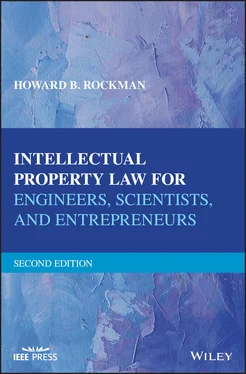7.3 THE INVENTION DISCLOSURE, AND THE INVENTION DISCLOSURE MEETING
7.3.1 Preparation of a Complete Description of the Structure and Function of the Invention, How the Invention Operates, and What Advantageous Results Are Obtained by the Invention
The patent application ultimately prepared covering the invention must contain sketches or illustrations showing the important elements of the invention, where the invention comprises an article of manufacture, machinery, an electronic circuit, electrical circuit or the like, as well as a specification comprising a complete description of the structure of the invention, followed by a description of one cycle of operation of the described structure. The description of the structure and operation of your invention are keyed to the drawings through the use of reference numerals and lead lines identifying parts in the drawing that are described in the patent specification, somewhat similar to technical drawings. Therefore, it is important that the inventor or inventors prepare an adequate disclosure of the invention, with sketches and a description of the structure and function of the operation, prior to meeting with the patent professional at an initial invention disclosure meeting. It is no secret that patent agents and lawyers charge for their time, and an inventor can save substantial time, and thus money, by shortening the time the patent lawyer or agent has to spend preparing the patent application. By preparing detailed sketches and descriptions of the invention for presentation to the patent professional, hundreds and possibly thousands of dollars can be saved in the cost of obtaining and prosecuting the patent application. There are additional materials and information that the inventor or inventors should bring to the invention disclosure meeting with the patent professional, which will be covered in more detail as this chapter proceeds.
Your initial invention disclosure must be clear, although it is not necessary that it be typewritten. Also, a good disclosure is not necessarily long, but the important features of the invention and their operation and advantages must be adequately disclosed. When submitting your invention disclosure, always give the benefit of the doubt to including more in your disclosure rather than omitting information. The patent attorney can help decide what information you provide should be made part of the patent application, and which should not. Any drawings or sketches you prepare to submit to the patent attorney should be clear and sufficiently detailed, and coordinated with your written description. This is accomplished by numbering the various parts of the invention on the drawing and keying the numbers with the written disclosure. If you submit alternative embodiments, also submit the drawings or illustrations directed to those alternatives. If a model of the invention has been prepared, submit the model to the patent attorney with the other descriptive materials. Photographs of your model can also be used as the basis for the drawings initially filed with the patent application.
The key factor in preparing the initial disclosure of the invention and its different embodiments is to remember to present all information you know about your invention, and the environment in which it functions, to the patent attorney, leaving nothing out. The more information about your invention in the patent application, the more difficult it is for a potential infringer to design around your patent coverage. As will be explained in Chapter 10, the claims in your patent application will be drawn to cover all embodiments of your invention, and hopefully these claims will later be interpreted to cover those competing devices marketed in the future that are directed toward solving the same problems that your invention is directed toward solving.
7.3.2 Disclosing the Best Mode of the Invention
The U.S. Patent Law, for many years, has required that the ones seeking patent protection disclose the “best mode” of practicing the subject invention in the patent application. This requirement is retained in the AIA, which ensures that their invention that goes into the public domain is the best version of the invention conceived and reduced to practice from the inventor(s), rather than some inferior version.
However, the AIA removes any penalty for failing to disclose the best mode of the invention in a patent application by stating that “the failure to disclose the best mode shall not be a basis on which any claim of a patent may be cancelled or held invalid or otherwise unenforceable…” (35 U.S.C. §282(b)(3)(A)). Despite this, 35 U.S.C. §112(a) of the new AIA Patent Law, in mandating the contents of a patent application specification, states that the applicant “shall set forth the best mode contemplated by the inventor or joint inventor of carrying out the invention.” The new law also provides that a patent application filed first in a foreign country and then filed in the United States does not have to disclose the best mode of the invention.
The consensus is that this removal of the defense of the failure to disclose the best mode in a patent application was enacted to accommodate global patent harmonization efforts, since, generally, foreign patent statutes do not have a best mode requirement.
In addition, in the way the AIA has changed this element of the Patent Law, it appears that, even though a patent applicant is required to disclose the best mode of practicing the invention in the patent application, the lack of best mode cannot be raised by third parties in post‐grant reviews of patents newly authorized by the AIA.
Theoretically, a Patent Examiner could still reject a patent application on the grounds of failing to disclose the best mode of the invention. However, since the USPTO rules do not allow a Patent Examiner to obtain information from the applicant through a “discovery” process as used in litigation in the United States, the examiner has practically no way of determining whether or not the inventor has disclosed the best mode.
In my opinion, this is one of the conundrums that may be understood further as time goes by, and as future court decisions consider this point.
In my judgment, best practices dictate that the disclosure of the invention in the patent application must be of the best mode of practicing the invention known to the inventor at the time of the invention disclosure meeting. Since there is a time lag between the first meeting with the patent attorney and the actual completion of the patent application, if the invention has been improved during that time period, the later developments must be described to the patent attorney, so that the latest, best mode of the invention can be included in the patent application upon filing. Also, if the inventors have developed alternative embodiments of the invention during this time period, these should be described so that the patent attorney can determine which of the alternative embodiments should also be described in the patent application. Each and every remote possible embodiment does not need to be described, but the presentation of alternate embodiments helps the lawyer draft the description and claims in the patent application to provide broad enough protection to cover any manifestation of the invention that a potential infringer could later develop.
7.3.3 Dates of First Public Disclosure, If Any, and What Was Disclosed
As we have already discussed, if an invention was in public use or on sale, or offered for sale anywhere more than a year before the date that the invention is initially disclosed to the patent attorney, patent protection cannot be obtained for that particular invention. In those cases, I have usually advised inventors to develop an improvement to their invention, and then a patent application can be filed covering the improvement. However, the prior public activities of the inventor more than a year before the filing of the patent application may have destroyed any patent rights the inventor might have obtained in the original invention.
Читать дальше












